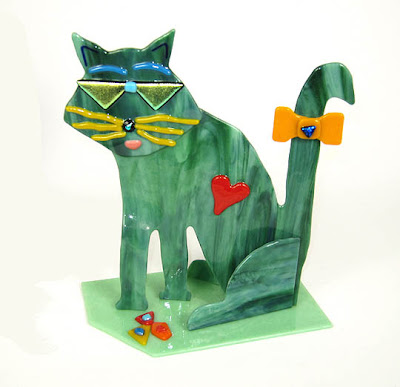By Judy Feldman | www.wildemeyer.com
In my last blog, I talked about three sculptors who have found their artistic expression in three-dimensional art. All of them said that they love the feel of creating art in a tactile way. You could say the sense of touch is an integral part of their work.
To continue this theme, I talked to three other 3D artists who display at the gallery. The first two are ceramicists, whose tactile expressions are revealed directly in their art. The third is a glass artist, whose journey to a finished piece is a little more complicated.
Kari Rives began her artistic career as a painter, favoring a palette knife and her fingers instead of brushes, to create highly textured work. Her love of a hands-on technique led her to try ceramics, combining her painterly skills with modeling. “Clay made good sense to me,” she says. “Its tactile nature provides a great opportunity for expressive gesture, and I prefer to leave the evidence of my touch.”
You can see an example of Kari’s mark making on her ceramics in two charming sculptures, entitled “Hedgerow” and “Bruce” (shown above). She doesn’t sketch before sculpting, and although she refers to photos, she doesn’t strive for realism, saying that “an animal speaks to me, so I feel an emotion and convey life in the piece.”
Although Kari enjoys the painterly part of coloring her sculptures, she likes the uncertainty that results from firing a piece. “You really don’t know what’s going to happen, and the surprises can be great” she says. Often, she’ll re-fire a sculpture, sometimes as much as eight times, to achieve depth and layers of color. I think you can see these layers in her piece entitled “Emerald Turtle.”
Michelle MacKenzie also started exploring art as a painter. But she, too, loves the tactile thrill of “taking a ball of clay and creating something beautiful from it.” And, she adds, “When it’s done you can touch it!” Michelle is passionate about animals and looks to them for inspiration. She has a keen interest in birds, and says “Birds symbolize life to me. Sculpting them is so delightful. As I work, they’re in the palm of my hand and their face is looking up at me.”
Michelle’s bird series is charming. She uses old wire to form a nest, makes ceramic eggs and creates a family setting with a mother bird. Here’s an example of her bird collection:
For her sculpture entitled “Quail on a Rock,” she uses a horseshoe nail to create the quail’s topnotch.
Always on the lookout for found objects, Michelle likes to mix up her mediums. For her sculpture “Guardian,” she re-finished an old shutter door, added trim where the hinges had been and created a ceramic bas relief to depict the wolves as “animal spirits of the forest.” Although it’s meant to be hung on a wall, this piece still offers the texture and depth of three-dimensional art.
Although Tom Philabaum had a natural ability to draw and paint as a child, his initial pursuit in college was academics, But when he decided to take a ceramics class, he says “the clay grabbed me.” Tom focused on hand building, working in such a large scale that his instructor told him that his ideas were too fluid for clay, and that he should try glass.
A chance meeting in Wisconsin with Harvey Littleton changed the course of Tom’s artistic career. (Littleton and glass scientist Dominick Labino introduced glass as an art medium in 1962, and Littleton taught the first glass-blowing class in an American college at the University of Wisconsin-Madison.) Tom was drawn to the expressive possibilities of glass, and, under the tutelage of Harvey Littleton, was encouraged to push the boundaries of artistic expression in that medium. He started to work with glass in the same way he had worked with clay: by creating shapes and constructing objects with them. “I use heat instead of water to make the material flow,” he explains.
You can see the unique way Tom fashions glass in his rock sculptures, made of blown glass and fashioned together. In pieces like “Small Gourd” and “Round Paperweight”, the balls of glass appear to be floating, yet delicately attached. The shimmering, multi-colored hues of the sculptures look so ethereal.
Tom says that he has learned the principles of chemistry and physics through glass making. His various techniques require new understandings of the medium each time he tries a different idea. For his sculpture entitled “Wrapped,” he combines two mediums: clay and kiln cast glass, making a form in clay, a mold from that and then pouring glass into the mold to create the final piece. In his series called “Handbuilts,” he makes coils with molten glass and then creates a form such as the vessel entitled “Canasta 18.”
A recent exploration has led Tom to a fusion of glass making and painting. “River Road” is an example of his fused glass collage painting series. In this multi-step, complex process, 2D and 3D have a chance to meet!









































